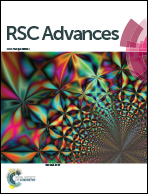A novel strategy for enhancing the electrospun PVDF support layer of thin-film composite forward osmosis membranes†
Abstract
A simple and novel treatment methodology is introduced to produce PVDF-based thin-film composite forward osmosis (TFC-FO) electrospun membranes for enhanced desalination performance. The proposed treatment strategy is based on improving the surface properties of the PVDF electrospun nanofiber support layer using triethylamine (TEA). The results indicated that this strategy enhanced the interfacial polymerization step by overcoming the hydrophobicity feature dilemma of the PVDF support layer. As an FO membrane, the characterization of the modified membrane shows a distinct decrease in the structure parameter of the support layer by 67%, which mitigates the adverse effect of the internal concentration polarization (ICP) by 45%. Moreover, the performance of the modified TFC-FO membrane exhibited a high water flux, approximately 68 LMH and low reverse salt flux, about 2 g m−2 h−1 at 2 M NaCl draw solution, with >99.5% salt rejection. Overall, the introduced modification technique has the advantages of being inexpensive, easy to implement, and appropriate for commercial membranes.


 Please wait while we load your content...
Please wait while we load your content...